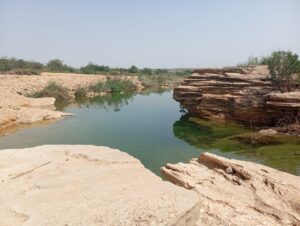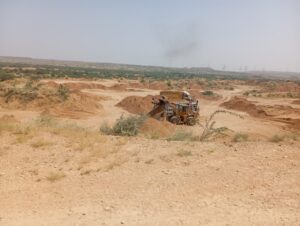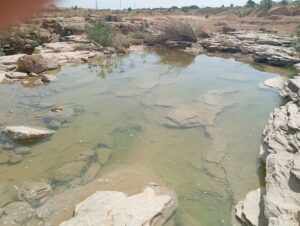 LAKSHA KUMARI
LAKSHA KUMARI
The Price of Progress…….
Just a decade ago, Gadap — a serene region on the outskirts of Karachi’s Malir District — was a world apart from the city’s chaos. Lush forests stretched over rolling hills, streams fed fertile farmlands, and birds filled the air around Lahoti Waterfall — a popular picnic spot where families came to breathe in the cool, clean breeze. Farmers tilled the soil passed down through generations, growing crops that nourished both land and life.
But after 2013, the rhythm of Gadap’s natural life began to falter. Bulldozers replaced bullocks, and the song of birds was drowned by the growl of heavy machinery. With the rise of Bahria Town’s mega construction projects, an insatiable demand for sand, gravel (bajri), and silicon rock ignited an aggressive wave of mining across the region. Hills were razed, forests stripped bare, and groundwater tables plunged deeper each year.
The consequences were immediate — and devastating. Winters lost their gentle chill, summers turned merciless, and rainfall became erratic. Where once the air smelled of wet soil, it now carries choking dust and diesel fumes. The earth has grown tired — cracked, dry, and barren. Farmers who once relied on rich soil now watch their crops wither before harvest. “The land no longer breathes,” says an elderly farmer from Gadap. “It burns beneath our feet.”
 Despite laws meant to protect forests and wildlife, powerful construction interests continue unchecked, shielded by influence and silence. Mining trucks roll day and night, often without permits or environmental clearance. Some even dump Bahria Town’s waste back into the area — poisoning the land that once fed local communities. The dust hangs thick over villages, and children cough through sleepless nights. Respiratory illnesses, eye infections, and skin diseases are now part of daily life.
Despite laws meant to protect forests and wildlife, powerful construction interests continue unchecked, shielded by influence and silence. Mining trucks roll day and night, often without permits or environmental clearance. Some even dump Bahria Town’s waste back into the area — poisoning the land that once fed local communities. The dust hangs thick over villages, and children cough through sleepless nights. Respiratory illnesses, eye infections, and skin diseases are now part of daily life.
The social fabric is unraveling too. Many families have been forced to abandon their farms, seeking work elsewhere as livelihoods crumble. Once-proud farmers are turning into daily-wage laborers for the very companies that destroyed their fields.
Reporting this crisis was not without danger. While gathering evidence, I faced intimidation and subtle threats — a reminder of how deeply entrenched the mining networks are. But silence is not an option. By working discreetly, earning the trust of local sources, and cross-verifying information, I was able to uncover the hidden reality behind Gadap’s vanishing greenery.
Yet amid despair, hope flickers. Environmental groups and youth volunteers have begun small-scale tree planting campaigns. Experts urge the government to impose strict regulations on mining, restore natural water channels, and ensure transparency in environmental impact assessments.
 Reviving Gadap means giving nature — and its people — a chance to heal. It requires sustainable mining practices, waste control, and community participation at every level. Technology can also play a role: satellite imagery and hydrological studies can help map the damage and guide recovery efforts.
Reviving Gadap means giving nature — and its people — a chance to heal. It requires sustainable mining practices, waste control, and community participation at every level. Technology can also play a role: satellite imagery and hydrological studies can help map the damage and guide recovery efforts.
But time is running out. The fate of Gadap is not a distant issue — it mirrors what is happening across Sindh, where unchecked urban expansion threatens ecosystems and communities alike. What’s lost here is not just a patch of land — it’s a living, breathing part of our environmental identity.
Gadap’s story is a warning — and a call to action. If we continue to dig without conscience, we may soon find there is nothing left to stand on.
